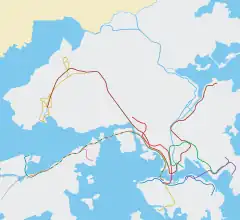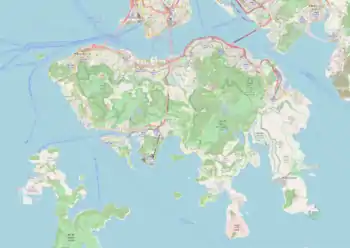Causeway Bay 銅鑼灣 | |||||||||||||||||||||||||||||||||||||||||||||||||||||||||||||||
|---|---|---|---|---|---|---|---|---|---|---|---|---|---|---|---|---|---|---|---|---|---|---|---|---|---|---|---|---|---|---|---|---|---|---|---|---|---|---|---|---|---|---|---|---|---|---|---|---|---|---|---|---|---|---|---|---|---|---|---|---|---|---|---|
 Platform 2 (2021) | |||||||||||||||||||||||||||||||||||||||||||||||||||||||||||||||
| Chinese name | |||||||||||||||||||||||||||||||||||||||||||||||||||||||||||||||
| Traditional Chinese | 銅鑼灣 | ||||||||||||||||||||||||||||||||||||||||||||||||||||||||||||||
| Simplified Chinese | 铜锣湾 | ||||||||||||||||||||||||||||||||||||||||||||||||||||||||||||||
| Hanyu Pinyin | Tóngluówān | ||||||||||||||||||||||||||||||||||||||||||||||||||||||||||||||
| Cantonese Yale | Tùnglòwāan | ||||||||||||||||||||||||||||||||||||||||||||||||||||||||||||||
| Literal meaning | Copper gong bay | ||||||||||||||||||||||||||||||||||||||||||||||||||||||||||||||
| |||||||||||||||||||||||||||||||||||||||||||||||||||||||||||||||
| General information | |||||||||||||||||||||||||||||||||||||||||||||||||||||||||||||||
| Location | Hennessy Road × Yee Wo Street, East Point Wan Chai District, Hong Kong | ||||||||||||||||||||||||||||||||||||||||||||||||||||||||||||||
| Coordinates | 22°16′49″N 114°11′01″E / 22.2802°N 114.1835°E | ||||||||||||||||||||||||||||||||||||||||||||||||||||||||||||||
| Owned by | MTR Corporation | ||||||||||||||||||||||||||||||||||||||||||||||||||||||||||||||
| Operated by | MTR Corporation | ||||||||||||||||||||||||||||||||||||||||||||||||||||||||||||||
| Line(s) | Island line | ||||||||||||||||||||||||||||||||||||||||||||||||||||||||||||||
| Platforms | 2 (2 split level side platforms) | ||||||||||||||||||||||||||||||||||||||||||||||||||||||||||||||
| Tracks | 2 | ||||||||||||||||||||||||||||||||||||||||||||||||||||||||||||||
| Connections | |||||||||||||||||||||||||||||||||||||||||||||||||||||||||||||||
| Construction | |||||||||||||||||||||||||||||||||||||||||||||||||||||||||||||||
| Structure type | Underground | ||||||||||||||||||||||||||||||||||||||||||||||||||||||||||||||
| Depth | 30 m (98 ft) | ||||||||||||||||||||||||||||||||||||||||||||||||||||||||||||||
| Platform levels | 2 | ||||||||||||||||||||||||||||||||||||||||||||||||||||||||||||||
| Accessible | Yes | ||||||||||||||||||||||||||||||||||||||||||||||||||||||||||||||
| Other information | |||||||||||||||||||||||||||||||||||||||||||||||||||||||||||||||
| Station code | CAB | ||||||||||||||||||||||||||||||||||||||||||||||||||||||||||||||
| History | |||||||||||||||||||||||||||||||||||||||||||||||||||||||||||||||
| Opened | 31 May 1985 | ||||||||||||||||||||||||||||||||||||||||||||||||||||||||||||||
| Previous names | East Point | ||||||||||||||||||||||||||||||||||||||||||||||||||||||||||||||
| Services | |||||||||||||||||||||||||||||||||||||||||||||||||||||||||||||||
| |||||||||||||||||||||||||||||||||||||||||||||||||||||||||||||||
| |||||||||||||||||||||||||||||||||||||||||||||||||||||||||||||||
| Location | |||||||||||||||||||||||||||||||||||||||||||||||||||||||||||||||
 Causeway Bay Location within the MTR system  Causeway Bay Causeway Bay (Hong Kong urban core)  Causeway Bay Causeway Bay (Hong Kong Island) | |||||||||||||||||||||||||||||||||||||||||||||||||||||||||||||||
Causeway Bay (Chinese: 銅鑼灣; Cantonese Yale: Tùnglòwāan) is a station on the MTR network on Hong Kong Island, Hong Kong. The station is between Wan Chai and Tin Hau stations on the Island line.[1] It serves the locality of East Point within Wan Chai District.
History
In 1967, Freeman Fox and Wilbur Smith Associates released the government-commissioned Mass Transport Study, which proposed a new underground railway. The plan included the Island line between Kennedy Town and Chai Wan stations.[2] When the Mass Transport Provisional Authority was founded, minor alterations were made with the Sheung Wan to Kennedy Town section cancelled.[note 1] The government gave approval on the 95-million-dollar construction of the line on 23 December 1980[3] and work started in October 1982. In 1984, the station construction site was sold by MTR to Taisei Corporation for $380m, now the location of Sogo Hong Kong.[4] The station opened with the first section of the Island line from Admiralty to Chai Wan on 31 May 1985.[2]
Services
The station is situated between Wan Chai and Tin Hau stations on theIsland line.[1] The typical off-peak service is 17 trains per hour in both directions, which is a train every 3–6 minutes.[5]
Station layout
The platforms of Causeway Bay station are constructed in a stacked arrangement, with platform 1 above platform 2.
| G | Ground level | Exits |
| - | Western Concourse | Vending machines, ATM |
| L1 Concourses |
Eastern Concourse | Customer Service, MTRShops |
| Hang Seng Bank, vending machines, ATM | ||
| Octopus promotion machine, tourist information centre | ||
| Western Concourse | Customer Service | |
| ATM, i-centre internet service | ||
| L2 Platform |
Side platform, doors will open on the left | |
| Platform 1 | Island line towards Chai Wan (Tin Hau) → | |
| L3 Concourse |
Southern Concourse | Customer Service |
| Vending machines, ATM, Octopus Promotion Machine | ||
| L5 Platform |
Side platform, doors will open on the right | |
| Platform 2 | ← Island line towards Kennedy Town (Wan Chai) | |
 Platform 1 (2021)
Platform 1 (2021) West Concourse (2018)
West Concourse (2018) East Concourse (2017)
East Concourse (2017) South Concourse (2018)
South Concourse (2018)
Entrances/exits
Causeway Bay is a primary shopping district in Hong Kong[note 2] with exits from the MTR leading directly into major outlets such as Sogo and Times Square, which can be accessed through a long, upward sloping pedestrian walkway at Exit A.
Unlike other MTR stations, there are three different concourses in Causeway Bay station. After exiting the paid areas through the turnstiles, the other two concourses are inaccessible underground. The west and east concourses were opened on 31 May 1985 with the opening of the station, while the south concourse and Exit A were opened in 1994 with the opening of Times Square.
 Exit B (2020)
Exit B (2020) Exit C (2020)
Exit C (2020) Lift access (2018)
Lift access (2018) Exit E (2020)
Exit E (2020)
South concourse
In the basement of Times Square:
- A: Times Square[8]
West concourse
In the basement of Causeway Bay Plaza (Phase 1):
- B: Causeway Bay Plaza
- C: Sino Plaza[8]
East concourse
In the basement of Sogo Department Store:
- D1
 /D2/D3/D4: Sogo Department Store
/D2/D3/D4: Sogo Department Store - E: Victoria Park
- F1: Jardine's Crescent
- F2: Hysan Place[8]
Transport connections
Bus routes
These are the bus routes found in the vicinity of Causeway Bay station that provide connections with other areas not served by the MTR including Aberdeen/Wah Kwai Estate, Braemar Hill, Happy Valley, Jardine's Lookout, Kennedy Town, Lai Tak Tsuen, Lei Tung Estate, Park Road, Sham Wan/Wong Chuk Hang, Nam Cheong station/Hoi Lai Estate, South Horizons, The Peak, Tin Wan, Tsing Yi/Cheung On, Wah Fu.
Hong Kong Tramways
Hong Kong Island's tramway system consists of an inner loop branching out at Causeway Bay towards Happy Valley. The nearest tram stop is located along Percival Street near the end of Matheson Street.
Plans to expand Causeway Bay station
In November 2006, MTR announced they would build an underground shopping mall and expand the current Causeway Bay station. The station will add 5 new exits:
- E1: East Point Road
- E2: Great George Street at Hong Kong Building
- F1: Former Hennessy Centre
- F2: Yee Wo Street at McDonald's Building
- F3: Paterson Street
and the current Exit E (Great George Street next to The Body Shop) will be removed. The plan also triples the current station size.
Gallery
 Platform 2 (2013)
Platform 2 (2013) Causeway Bay station East Concourse (2011)
Causeway Bay station East Concourse (2011)
Notes
- ↑ Phase 2 of the railway system includes the Sheung Wan to Admiralty section, and Admiralty to North Point while Phase 8 will be from North Point to Chai Wan.[2] The plan still included the Sheung Wan to Kennedy Town section, but construction did not commence on that section of line.[2]
- ↑ This causes the station to be very busy all day long.[7]
References
- 1 2 "MTR system map" (PDF). MTR. Retrieved 27 May 2016.
- 1 2 3 4 "歷史". MTR之今昔Expo (in Cantonese). MTR之今昔. Retrieved 27 May 2016.
- ↑ "歷史". 港島線 (in Cantonese). 台灣Word. 6 December 2013. Retrieved 27 May 2016.
- ↑ Sim, Suzanne (7 April 1984). "MTR Causeway Bay site fetches $380m" (PDF). South China Morning Post. Retrieved 22 March 2021.
- ↑ "Service Hours". Services and Facilities. MTR. Retrieved 27 May 2016.
- ↑ "Causeway Bay Station layout" (PDF). MTR Corporation. Retrieved 31 July 2014.
- ↑ "銅鑼灣 Causeway Bay (CAB)". 港島線簡介 (in Cantonese). MTR之今昔. Retrieved 27 May 2016.
- 1 2 3 "Causeway Bay Station street map" (PDF). MTR Corporation. Retrieved 31 July 2014.
External links
 Media related to Causeway Bay Station at Wikimedia Commons
Media related to Causeway Bay Station at Wikimedia Commons